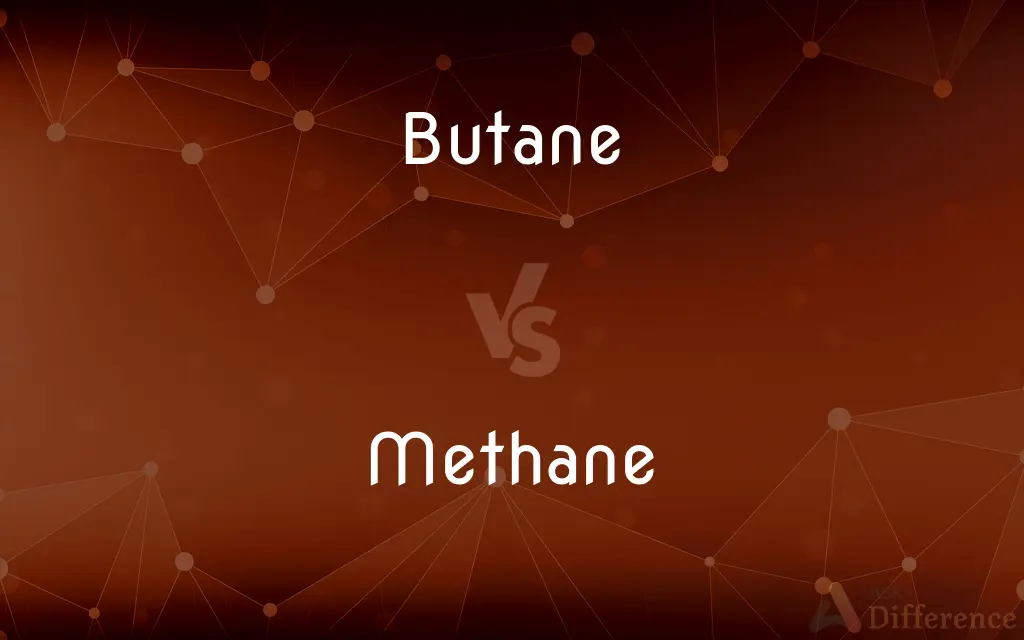Butane vs. Methane — What's the Difference?
Edited by Tayyaba Rehman — By Urooj Arif — Updated on April 1, 2024
Butane is a heavier hydrocarbon with a higher boiling point, used as fuel in lighters, while methane is a lighter, more abundant gas, critical for natural gas energy.

Difference Between Butane and Methane
Table of Contents
ADVERTISEMENT
Key Differences
Butane, a hydrocarbon with four carbon atoms, is commonly used in lighters and as a fuel for portable stoves due to its higher boiling point. On the other hand, methane, the simplest hydrocarbon with one carbon atom, serves as a major component of natural gas and is pivotal in energy production due to its abundance and lower boiling point.
Butane's molecular structure allows it to exist as a liquid at slightly higher temperatures, making it practical for storage and transport in canisters. Whereas methane, with its simpler structure, remains gaseous under most conditions, requiring compression or liquefaction for similar applications.
In terms of environmental impact, butane releases more carbon dioxide per molecule when burned compared to methane. However, methane is a more potent greenhouse gas, contributing significantly to global warming when released unburned into the atmosphere.
Butane finds its applications in lighter fuel, refrigerants, and portable cooking fuel, capitalizing on its liquefiable nature. Methane, however, is primarily used for heating, electricity generation, and as a feedstock for producing chemicals, leveraging its abundance and clean-burning properties.
Despite butane’s utility in consumer products, methane’s role in energy production and as a greenhouse gas makes it more influential on a global scale. Butane’s use is limited by its physical properties and applications, whereas methane’s impact spans environmental, industrial, and energy sectors.
ADVERTISEMENT
Comparison Chart
Molecular Formula
C4H10
CH4
Boiling Point
-0.5°C (31.1°F)
-161°C (-257.8°F)
Primary Use
Lighter fuel, portable stoves
Natural gas energy, chemical feedstock
Environmental Impact
Higher CO2 emissions per molecule
More potent greenhouse gas
State at Room Temperature
Gas (liquefies under pressure)
Gas
Compare with Definitions
Butane
A component of liquefied petroleum gas (LPG).
Portable stoves often use butane canisters.
Methane
Can be converted into synthetic fuels.
Methane is a base for producing methanol.
Butane
A hydrocarbon gas with the formula C4H10, used as a fuel.
Butane is popular in refillable lighters.
Methane
A greenhouse gas contributing to global warming.
Reducing methane emissions is crucial for climate control.
Butane
Utilized as a refrigerant in some cooling systems.
Butane is used in refrigerators as an eco-friendly option.
Methane
Used in electricity generation through gas turbines.
Methane powers several electricity plants worldwide.
Butane
Found in both isobutane and n-butane forms.
Isobutane is a common propellant in aerosol sprays.
Methane
Exists predominantly in gaseous form under normal conditions.
Methane requires compression to be transported.
Butane
Can be liquefied easily, making it portable.
Liquefied butane fuels many camping stoves.
Methane
The simplest alkane, with a formula of CH4, a major component of natural gas.
Methane is extracted from underground reservoirs.
Butane
Butane () or n-butane is an alkane with the formula C4H10. Butane is a gas at room temperature and atmospheric pressure.
Methane
Methane (US: , UK: ) is a chemical compound with the chemical formula CH4 (one atom of carbon and four atoms of hydrogen). It is a group-14 hydride and the simplest alkane and is the main constituent of natural gas.
Butane
Either of two isomers of a gaseous hydrocarbon, C4H10, produced synthetically from petroleum and used as a household fuel, refrigerant, and aerosol propellant and in the manufacture of synthetic rubber.
Methane
An odorless, colorless, flammable gas, CH4, the major constituent of natural gas, that is used as a fuel and is an important source of hydrogen and a wide variety of organic compounds.
Butane
(organic compound) A hydrocarbon (either of the two isomers of C4H10 n-butane, and 2-methyl-propane) found in gaseous petroleum fractions.
Methane
The simplest aliphatic hydrocarbon, CH₄, being a constituent of natural gas, and one of the most abundant greenhouse gases.
Greenhouse gas
Cattle emit a large amount of methane.
Butane
The n-butane isomer only.
Methane
Any of very many derivatives of methane.
Butane
An inflammable gaseous saturated hydrocarbon, C4H10, of the marsh gas, or paraffin, series.
Methane
A light, colorless, gaseous, inflammable hydrocarbon, CH4; marsh gas. It is the simplest of the aliphatic hydrocarbons. See Marsh gas, under Gas.
Butane
Occurs in natural gas; used in the manufacture of rubber and fuels
Methane
A colorless odorless gas used as a fuel
Common Curiosities
How do butane and methane differ in molecular structure?
Butane has four carbon atoms (C4H10), while methane has one carbon atom (CH4).
What is butane used for?
Butane is used as a fuel in lighters, portable stoves, and as a refrigerant.
Can both butane and methane be used for energy?
Yes, but methane is more commonly used for energy production due to its abundance and role in natural gas.
Is butane renewable?
Butane, like other hydrocarbons, is not renewable and is sourced from fossil fuels.
Which is more environmentally friendly, butane or methane?
While butane emits more CO2 when burned, methane is a more potent greenhouse gas if released into the atmosphere unburned.
Why is methane important?
Methane is a key component of natural gas, used for heating, electricity generation, and as a chemical feedstock.
What is the impact of butane and methane on global warming?
Methane has a more significant impact on global warming due to its potency as a greenhouse gas, while butane contributes to CO2 emissions.
What makes methane a greenhouse gas?
Methane traps heat in the atmosphere, contributing to global warming.
What is the boiling point of butane and methane?
Butane's boiling point is -0.5°C, whereas methane's boiling point is much lower at -161°C.
Can butane and methane be used interchangeably?
Due to differences in their properties and applications, they are not typically used interchangeably.
Are butane and methane gases at room temperature?
Yes, both are gases at room temperature, but butane can be liquefied more easily under pressure.
How is methane stored and transported?
Methane is compressed or liquefied for transportation and storage.
Do butane and methane have the same uses?
No, they are used in different applications due to their physical and chemical properties.
How are butane and methane produced?
Both are extracted from natural gas and oil reserves, with methane being the primary component of natural gas.
Are there any safety concerns with butane and methane?
Both gases are flammable and require careful handling to prevent leaks and explosions.
Share Your Discovery

Previous Comparison
Nap vs. Gap
Next Comparison
Context vs. AspectAuthor Spotlight
Written by
Urooj ArifUrooj is a skilled content writer at Ask Difference, known for her exceptional ability to simplify complex topics into engaging and informative content. With a passion for research and a flair for clear, concise writing, she consistently delivers articles that resonate with our diverse audience.
Edited by
Tayyaba RehmanTayyaba Rehman is a distinguished writer, currently serving as a primary contributor to askdifference.com. As a researcher in semantics and etymology, Tayyaba's passion for the complexity of languages and their distinctions has found a perfect home on the platform. Tayyaba delves into the intricacies of language, distinguishing between commonly confused words and phrases, thereby providing clarity for readers worldwide.














































